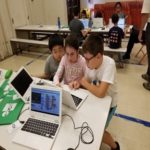THE FOLLOWING ARE 12 REASONS GIVEN BY LEADERS IN TECHNOLOGY ABOUT WHY KIDS NEED TO LEARN HOW TO CODE:
1. GIVES YOU SUPERPOWERS
“I believe technology should give us superpowers. Everyone should have the opportunity to learn to think, analyze, and create with technology.” Hilary Mason – Chief Scientist, Bitly
2. WE NEED TALENT
“Because our policy at Facebook is literally to hire as many talented engineers as we can find. There just aren’t enough people who are trained and have these skills today.” Mark Zuckerberg – Founder, Facebook
3. WE ALL DEPEND ON TECHNOLOGY
“Here we are, 2013. We ALL depend on technology to communicate to a bank. However none of us knows how to read and write code. It’s important for these kids. Right now, starting at 8 years old, to read and write code.” will.i.am – Musician/The Black Eyed Peas and Entrepreneur
4. YOU WON’T BE LEFT BEHIND
“One hundred years ago, people faced the choice of learning to read. Otherwise they could remain illiterate laborers. Society would leave them behind as have-nots. It is a rapidly modernizing world. In the coming century, being able to command the world that will be thoroughly computerized. It will set apart those who can live successfully in the future from those who will be utterly left behind.” Yishan Wong – CEO, Reddit
5. TEACHES YOU HOW TO THINK
“I think everybody in this country should learn how to program a computer. Because it teaches you how to think.” — STEVE JOBS, THE LOST INTERVIEW
6. UNLOCK CREATIVITY & OPEN DOORS
“Every student deserves the opportunity to learn computer programming. Coding can unlock creativity and open doors for an entire generation of American students. We need more coders — not just in the tech industry, but in every industry.” Mark Pincus – CEO and Founder, Zynga
7. FEEL EMPOWERED, GAIN CONFIDENCE
“Learning to code makes kids feel empowered. Also creative. And also confident. If we want our young women to retain these traits into adulthood, a great option is to expose them to computer programming in their youth.” Susan Wojcicki – Senior Vice President, Google
8. THINK ABOUT THINKING
“Programming allows you to think about thinking, and while debugging you learn to learn.” Nicholas Negroponte – Founder and Chairman Emeritus of MIT’s Media Lab
9. ACHIEVE YOUR DREAMS
“If you can program a computer, you can achieve your dreams. A computer doesn’t care about your family background, your gender, just that you know how to code. But we’re only teaching it in a small handful of schools, why?” Dick Costolo – CEO, Twitter
10. IT’S A NECESSARY 21ST CENTURY SKILL
“All of the today’s kids will need it. Along with reading, writing, and arithmetic. They require a basic understanding of computation and the role that it plays across a wide range of disciplines. Coding is engaging and empowering. It’s a necessary 21st Century skill.” Jan Cuny – Program Officer, National Science Foundation
11. NEED FOR DIVERSITY AND MULTIPLE PERSPECTIVES
“We must work diligently to democratize computer science learning so that no group is denied access to this fundamental knowledge. Not only is this an issue of civil rights, but computer science as a field desperately needs diverse and multiple perspectives.” Jane Margolis – Senior Researcher and Author, UCLA
12. BE CREATIVE, PROBLEM SOLVE AND LEARN TEAMWORK
“Are you creative? Do you love problem-solving? Is teamwork a strength? Do you want to have the power to change the world? If “yes” to all of these, then computer science – programming – is for you!” Ed Lazowska – Computer Science & Engineering, University of Washington



